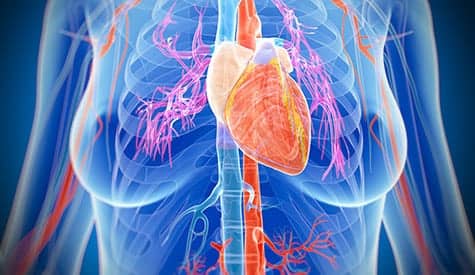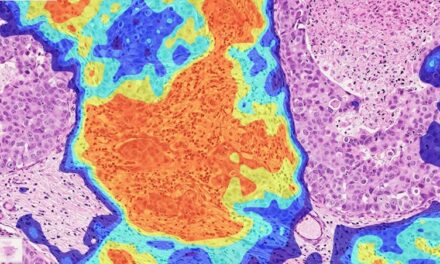
BY KAREN APPOLD
Cardiovascular disease is the number one killer of women in the United States1 and around the world.2 More women die from heart disease than all forms of cancer combined.
“What’s even more frightening is that 64% of women who die suddenly from heart disease have had no previous symptoms,” says Mary Ann Bauman, MD, medical director, Women’s Health and Community Relations, INTEGRIS Health, Oklahoma City, and national spokesperson for the American Heart Association’s Go Red for Women campaign. “But the good news is that heart disease is largely preventable. That is why knowing the risk factors and modifying your lifestyle is so important.”
People can’t change their family history, but they can change the other factors, Bauman notes. Risk factors for heart disease, the same for women and men, include hypertension, high cholesterol, hyperlipidemia, diabetes, obesity, sedentary lifestyle, smoking, and family history, Bauman notes.
 |
“More women die from heart disease than all forms of cancer combined. “What’s even more frightening is that 64% of women who die suddenly from heart disease have had no previous symptoms.”—Mary Ann Bauman, MD, medical director, Women’s Health and Community Relations, INTEGRIS Health, and national spokesperson for the American Heart Association’s Go Red for Women campaign |
Michelle O’Donoghue, MD, cardiologist, Brigham and Women’s Hospital, Boston, says “We are only beginning to better understand the important role that genetics may play in the development of heart disease.” In particular, research is under way to help identify specific genetic variants that may contribute to developing coronary artery disease.
Although heart disease risk increases for both men and women as they age, women’s symptoms can become more evident after menopause. Although menopause does not cause heart disease, risk factors that have been present for years will begin to exact a toll when menopause occurs. About 10 years after menopause, an increase in heart attacks is seen in women. “Lack of estrogen may play a role because we think it helps to keep blood vessels flexible, but other factors are involved as well,” Bauman says, adding that we don’t have all of the answers yet.
Compared to men, women are more affected by metabolic syndrome (a combination of medical disorders that increase the risk of developing cardiovascular disease and diabetes). This condition is characterized by fat around the abdomen, high blood pressure, elevated fasting blood sugar, and high triglycerides and/or low HDL (good cholesterol). Having three of these five factors is indicative of metabolic syndrome.
| “We are only beginning to better understand the important role that genetics may play in the development of heart disease.”—Michelle O’Donoghue, MD, cardiologist, Brigham and Women’s Hospital |  |
STUDIES FOCUS ON NEWER RISK FACTORS
A recent study published in Lipids in Health and Disease3 explores the apoA1 remnant ratio (apoA1/[VLDL3c+IDLc) as a new risk marker in women over age 50. “Mortality rates in women after an acute heart attack are higher than men—necessitating [that] clinicians recognize and address this risk in female patients,” says Michael E. Cobble, MD, fellow of the American Board of Clinical Lipidology and the National Lipid Association, and chief medical officer, Atherotech Diagnostics Lab, Birmingham, Ala.
VLDL3c+IDLc represents the triglyceride-rich remnant lipoprotein (RLP) leftovers of non-HDLc (NHDLc). These RLPs can have a significant negative impact on coronary heart disease risk, especially when combined with lower levels of apoA1.
According to the study, the apoA1 remnant ratio in post-menopausal women is the strongest predictor of myocardial injury/death. Compared to basic cholesterol measurements such as LDLc, HDLc, and total cholesterol, the remnant ratio helps to better predict heart attack risk in post-menopausal women, Cobble says.
 |
“Mortality rates in women after an acute heart attack are higher than men—necessitating [that] clinicians recognize and address this risk in female patients.”—Michael E. Cobble, MD, fellow of the American Board of Clinical Lipidology and the National Lipid Association, and chief medical officer, Atherotech Diagnostics Lab |
On another front, because inflammation drives the development of atherosclerotic plaque build-up in heart arteries, “There is growing interest in the use of novel markers of inflammation that help to identify women who may not have established risk factors and yet are at an increased risk of a cardiac event,” O’Donoghue says. Extensive research has been done on the prognostic utility of high-sensitivity C-reactive protein (hsCRP), a known marker of inflammation. Numerous studies have shown that higher levels of hsCRP are significantly associated with an increased risk of cardiovascular events in primary prevention and hsCRP provides incremental value for risk stratification that is independent of established risk factors. The Reynold’s risk score was specifically developed for women in the primary prevention setting and is a simple risk score that quantifies 10-year cardiovascular risk based on the combination of established risk factors with hsCRP.
| “Measurement of LDLc alone often under-estimates a patient’s true risk for cardiovascular disease, especially in certain patient populations; for example, those who have signs of insulin resistance, risk factors associated with metabolic syndrome, patients on statins, and women on hormone therapy or who are post-menopausal.”—Deanna Franke, PhD, MT(ASCP), DABCC, clinical laboratory director, LipoScience Inc |  |
EVALUATING HER RISK
Many tests for heart disease exist. Some are designed to identify risk and some diagnose the disease. Here are some of the more common clinical laboratory tests that a physician might order.
• Lipid profile: Total cholesterol and HDL levels are two of the measures used to calculate the Framingham cardiovascular risk score.
• Glucose, hemoglobin A1C, glucose tolerance test: Each of these tests can identify or follow individuals who are at risk for or who have diabetes.
• Homocysteine: If you have high levels of this substance (which is used to make protein), you are at an increased risk of stroke, certain types of heart disease, and peripheral arterial disease.
• C-reactive protein: This is a measure of inflammation, (which increases cardiovascular risk, especially in women).
• LDH, CPK-MB, and troponin: These tests identify injury to the heart muscle. The substances are released during a heart attack.
• Brain natriuretic peptide (BNP): This tests for a specific protein released by an overworked heart. Elevations are a sign of heart failure.
A number of other nonlaboratory tests can evaluate and search for heart disease. Electrocardiograms are used to identify irregular rhythms, estimate heart size, and/or diagnose new or old heart attacks.
Echocardiograms provide a picture of the heart and allow for estimation of size, function, and abnormalities of the walls or valves. Calcium scoring estimates plaque buildup, which might help to identify obstructed arteries before they block off entirely. Stress tests are used to determine if the heart muscle is getting enough blood when it needs it—such as during exercise or stress. New technologies, including computed tomography and magnetic resonance imaging, can give an accurate picture of blood vessels.
 |
“Whether conducted in the central lab or at the point of care, cardiac tests—such as sensitive troponin—are key diagnosis tools.”—Jean Onofrio, senior director, global assay marketing, Siemens Healthcare Diagnostics |
THE LAB’S CRITICAL ROLE
Laboratory professionals play an increasingly important role in providing access to both traditional and novel cardiac biomarkers that are available throughout the disease continuum. “Whether conducted in the central lab or at the point of care, cardiac tests—such as sensitive troponin—are key diagnosis tools,” says Jean Onofrio, senior director, global assay marketing, Siemens Healthcare Diagnostics, Tarrytown, NY. “By leveraging the appropriate use of laboratory diagnostic testing, clinicians can help to enhance the assessment, diagnosis, and follow-up care for women with cardiovascular disease.”
As physicians gained experience using troponin and assays improved, the clinical use of troponin has evolved. “Originally, clinical performance matching creatine kinase MB was achieved using fairly high cut-offs for troponin,” says Bernard Cook, PhD, DABCC, FACB, manager, global scientific affairs, Beckman Coulter Inc, Brea, Calif. As clinicians learned that newer troponin assays could achieve better performance at lower cut-offs, clinical practice and guidelines changed, and the Food and Drug Administration recommended that troponin assay manufacturers demonstrate performance at the lower cut-offs being used in practice. Beckman Coulter recently received clearance for Access AccuTnI+3, the first troponin test that has been clinically validated using cut-offs around the 99th percentile. Access AccuTnI+3 can be used on all Beckman Coulter immunoassay systems.
| “Cardiac troponin assays and their clinical applications continue to evolve. As these tests become even more sensitive, it is likely physicians will use different (lower) cut-offs for females.”—Bernard Cook, PhD, DABCC, FACB, manager, global scientific affairs, Beckman Coulter Inc |
“Cardiac troponin assays and their clinical applications continue to evolve,” Cook says. “As these tests become even more sensitive, it is likely physicians will use different (lower) cut-offs for females.” Women average slightly lower troponin concentrations than men, even if current troponin assays cannot distinguish the difference.
 |
“Because women’s warning signs are much more subtle than men’s signs, it is especially important to be able to detect subclinical disease or patients who are at risk and may not experience recognizable symptoms of a heart attack.”—Douglas S. Harrington, MD, CEO, Aviir |
Today’s technologies offer many innovative features that benefit laboratories when evaluating patients for risk of heart disease or diagnosing it.
In addition to Beckman Coulter’s newest offering, here are some other products:
Siemens Healthcare Diagnostics offers multiple solutions for sensitive troponin I testing, which run on several core laboratory testing systems. “The assay helps to improve the diagnostic accuracy and rapid detection of myocardial injury—which in turn facilitates earlier detection of myocardial injury—enabling more rapid diagnosis and faster initiation of appropriate therapy,” Onofrio says.




LipoScience Inc, Raleigh, NC, offers the NMR LipoProfile® assay, which measures LDL-P. This allows physicians to better manage an individual’s risk for cardiovascular disease and personalize or adjust pharmacotherapy accordingly. “Measurement of LDLc simply looks at the amount of cholesterol within particles rather than the number of particles driving atherogenic plaque build-up,” says Deanna Franke, PhD, MT(ASCP), DABCC, clinical laboratory director. “Measurement of LDLc alone often under-estimates a patient’s true risk for cardiovascular disease, especially in certain patient populations; for example, those who have signs of insulin resistance, risk factors associated with metabolic syndrome, patients on statins, and women on hormone therapy or who are post-menopausal.”

Together, MIRISK and MIRISK VP evaluate both the lipid pathways and eight different vascular inflammation pathways of atherosclerosis and coronary heart disease. By thoroughly assessing the contribution of vascular inflammation, MIRISK VP provides advanced cardiac risk assessment of a patient’s true risk of a heart attack. MIRISK VP is unique because it looks at seven proteins in the blood that contribute to the number one cause of a heart attack—the rupture of vulnerable plaque—which is responsible for an estimated 75% of all heart attacks. “By adding to traditional cholesterol-based assessment methods and looking at protein biomarkers associated with vulnerable plaque pathways, MIRISK VP can give a physician a better understanding of his or her patient’s absolute risk of a heart attack within the next 5 years; even in patients with normal cholesterol levels and no symptoms,” he says.
Karen Appold is a contributing writer for CLP. For more information, contact Editor Judy O’Rourke at [email protected].
References
1. Women and Heart Disease Fact Sheet. Centers for Disease Control and Prevention. Available at: http://www.cdc.gov/dhdsp/data_statistics/fact_sheets/docs/fs_women_heart.pdf. Accessed Oct. 2, 2013.
2. Cardiovascular Disease in Women. World Heart Federation. Available at: http://www.world-heart-federation.org/press/fact-sheets/cardiovascular-disease-in-women/. Accessed Oct. 2, 2013.
3. May HT, Nelson JR, Kulkarni KR et al. A new ratio for better predicting future death/myocardial infarction than standard lipid measurements in women >50 years undergoing coronary angiography: the apolipoprotein A1 remnant ratio (Apo A1/ [VLDL3+IDL]). Lipids in Health and Disease. April 2013. Available at: http://www.lipidworld.com/content/12/1/55. Accessed October 9, 2013.
| RELATED CONTENT: |





